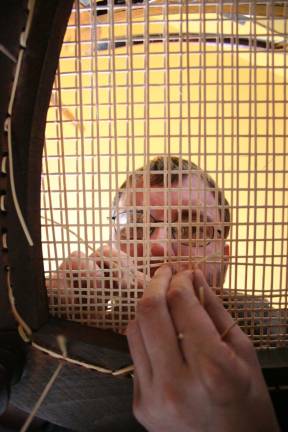Artisans in the shadow of Hudson Yards News

In a dusty, cluttered workshop that seems oddly out of place in modern New York City, a group of artisans is among the last still practicing a dying trade: chair caning.
The painstaking art of weaving a honeycomb pattern is still in demand to repair everything from ordinary household furniture to museum pieces. But the business on Manhattan’s gritty west side that was founded in the 19th century is being threatened by 21st century development.
The nation’s largest private building project -- Hudson Yards, a cluster of more than a dozen futuristic skyscrapers, plus shops and parks -- is quickly rising about 400 feet from the tiny shop.
“This is more than just about chairs; it’s about the changing face of New York City,” says Sean Bausert, 42, who hands-on runs Veteran’s Caning & Repair. “I understand gentrification, I understand it brings jobs, but we’re old New York! We’ve been around 116 years.”
The business, started in 1899 by a family member who had fought in the Spanish-American War (hence the name), is not part of the Hudson Yards project but nonetheless faces development pressures. The landlords of the brick tenement building that houses the shop have already been trying to buy tenants out. Some age-old buildings in the area have been demolished. Many other mom-and-pop businesses are already gone.
For now, the caning shop has a lease to stay through the spring of 2017. Whether Veteran’s is eventually pushed out “is a $64,000 question,” says Bausert. The company that manages the building, Silverstone Property Group, had no immediate comment.
Surrounding Bausert in his workshop were stacks of chairs ranging from an antique child rocker and sentimental heirlooms to Mies van der Rohe designs. Veteran’s customers include Sotheby’s and Manhattan’s Frick Collection but the shop is not above working on just plain, damaged furniture from anybody’s house.
In the back of the shop, two men are quietly weaving, pulling cane strips out of a bucket of warm water that keeps them pliable.
Hand-caned seats start at $250, machine-caned ones at $50, and complex, spider web-like patterns go into the thousands. One daybed cost $10,000 to mend.
It takes up to a year to train someone how to quickly and accurately turn cane into an intricate “open hole” pattern, fixing damage from what happens when someone -- or something -- breaks through the weave.
Bausert trained the shop’s current four employees after learning the trade from his 66-year-old father, John Bausert, who has published “The Complete Book of Wicker and Cane Furniture Making.”
But father and son say they’ll never divulge what Sean calls the family’s “closely guarded secret” -- a special tool that removes old cane easily and, he says, “cuts the time down dramatically.”
Without Veteran’s, there might be more discarded, broken chairs in curbside garbage, tossed out by owners who don’t know they can be repaired.
“We are dependent on these people,” says Glenn Adamson, director of Manhattan’s Museum of Arts and Design. “We might not notice them, but if this shop would go away, you would definitely miss it.”